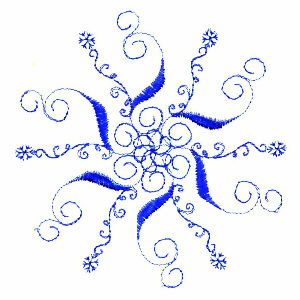Sewing Info
|
Sewing Info |
|
I am not going to say how many sewing machines I own, but since I got my Pfaff, I do all my sewing on it. Mainly, I quilt and do free motion embroidery. Occasionally I might even sew something. Just to show that I can use my machine to some degree of competence, here is a snowflake I made: |
|||||||||
|
SNOWFLAKE |
|||||||||
|
This snowflake was designed using my Pfaff, the stitches 158, 89, and the free download from the Pfaff site. |
|||||||||
 |
|||||||||
|
Another way I fill my days is by learning to digitize designs for the sewing machine. It has also increased my vocabulary but the words I have learned cannot be printed here. I have a Macintosh and the Pfaff software is fairly easy to use. But when I try to explain to Apple that I have my sewing machine hooked up to my computer, I am usually greeted with a long moment of silence and a question, ``You what?" |
|||||||||
|
Machine Quilting |
|
Large Quilts Large quilts are hard to machine quilt because of the bulk between the sewing machine and the needle. There are few ways around this dilemma. One solution is what I call the ``thirds" method. This is how I proceed: |
|
|
|
6. Cut on the dotted lines. Using masking tape, mark each side (i.e., left side and right side). 7. Take the middle piece of the batting and lay on the backing. |
|
|
|
Now you are ready to machine quilt. The top and back will roll up on the machine arm. You will still have a bunch of material to contend with, but not as much as when the batting is included. Do not quilt right up to the edge of the batting. I like to leave about an inch around the edges. When you have finished quilting the middle section of your quilt, attach one side of the batting as follows: 1. Fold back the backing and top, exposing the edge of the batting. 2. Butt the side batting edge to middle batting edge and zigzag together. I do this on my sewing machine using 9mm width and 6mm length. You can whip baste the pieces together by hand if you prefer. 3. Lay the quilt sandwich on a table, again stretching the backing. Pin baste the top down and machine quilt. Repeat for the other side. HINTS: 1. Machine wash all fabric prior to using. This removes the chemicals that are present in the fabric (formaldehyde is one). Alas, you have also removed all the sizing. But that is okay because - 2. Resize the backing using spray fabric sizing (some quilters like to use starch, but I prefer sizing) which is obtainable at any grocery store, or try Wally's world for the best price. If you size your backing, it will behave for you. What's your problem? You just bought a big piece of fabric and cut it up into little pieces, so resize. 3. When possible, quilt on the bias, less chance of pleats forming. 4. Use 100% cotton thread for quilting. It looks better. 5. Be sure and clean and oil your machine often. Cotton produces lots of lint and the lint loves to hide, especially behind your bobbin case. 6. The new safety pins that are curved are much easier to use than the old style. I like the #2 size. 7. A new product, quilt basting spray, has possibilities. I used it on a cot size quilt, followed direction about folding the backing, but ran into some problems. Next time I think I will stretch my backing and then spray. I have not tried the spray on a large size quilt, so don't know if it will hold. 8. Try to pin where you will not be quilting. Saves time because you don't have to stop and remove pins. |
|
|
||||||||||||||||||||||||||||||||||||||||||||||
|
This site is maintained by Spectrum Graphics Computer Designs. If you encounter any problems with this site, please contact them at: support@sgcd.com. |